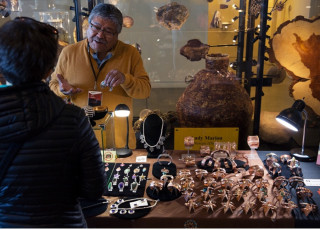Natural History Museum of Utah Anthropologists Use Grant Funds to Employ Indigineous Consults in a Step to Decolonize Native Collections
SALT LAKE CITY, UT—November 28, 2022— Last spring, the Natural History Museum of Utah (NHMU), Tanner Humanities Center, and the U’s Anthropology department received a substantial grant as part of NEH’s A More Perfect Union initiative, which selected projects that – among other things – investigate, examine, and work to express the experiences of Native Americans and other underrepresented communities throughout our wholly imperfect American history.
Led by Dr. Alexandra Greenwald, curator of ethnography at NHMU and assistant professor of anthropology at the University of Utah, NHMU has spent the last six months working with members of tribal communities throughout the Mountain West in a paid consultant capacity to share oral histories and Indigenous perspectives on ethnographic items in NHMU’s collections.
Historically, natural history museums have done a poor job collecting the deep cultural knowledge embedded in the objects they curate. NHMU’s primary goal with this initiative is to center Indigenous knowledge in its collections and solicit recommendations for how the Museum manages cultural objects and educates the public about them.
“We are honored and enthusiastic about the Native Voices Initiative, as well as grateful for the support of the National Endowment for the Humanities,” said Greenwald. “Museums have important roles as institutions to honor and preserve indigenous languages and cultures, both as an assistance to tribal communities – not as an authority over them – and with guidance from those tribal communities, and to educate the general public about Indigenous cultures.”
One recent consultant was 99-year-old Navajo weaver Rena Lane, who visited the ethnographic collections along with family members, including daughters Mary and Zena Lane, and nephew Sam Minkler. During the visit, both Rena and her family examined Navajo rugs and baskets from the collections and shared insights for audio and video recordings.
“It made an impression on my aunt that people really value Navajo works and she was in a place that valued the rugs, and the culture, and the people,” said Minkler after the visit. "And it adds validity to the research to ask input from someone who has been weaving for nearly a century."
In addition to funding these consultancies, the NEH grant provides support for six years of part-time University of Utah graduate students, for outreach and communication with tribal communities, and to record these oral histories for the purposes of knowledge, education, and preservation. These efforts aspire to acknowledge and attend to the devastating loss of Indigenous Knowledge-keepers to COVID-19, and to create a Tribal leadership-approved digital repository for each community.
“Coming to the Museum for an all day experience was a very unique experience,” said Brad Parry, Vice Chairman, Northwestern Band of the Shoshone Nation, who visited NHMU with Patty Timbimboo and Rios Pacheco. “The students had good questions, but they didn’t overask or anything. They let us just take in the moment. To be able to have the tribal elders hold some of the objects – some of whom donated those things to the museum – was an extremely valuable experience. We felt heard. It will be interesting to see where that goes. But from our perspective, well, we really appreciated it. That’s the first time we’ve ever been involved in anything like that.”
Overall, the grant funds support four components of the Native Voices Initiative:
● Conducting ethnographic interviews with tribal elders and craft specialists
● Developing a repository for these interviews in collaboration with tribal communities
● Informing an update to the Natural History Museum of Utah’s Native Voices exhibit
● Co-developing curriculum with inter-tribal youth organizations in partnership with the University of Utah’s Tanner Humanities Center
Actionable items to come out of the initiative include updates to NHMU storage and databases; updates to the Museum's Native Voices exhibition; digital imaging of objects (where appropriate) combined with video and audio recordings of interviews about them; creation of an open-source web platform to provide access to objects and information with tribal members (as well as tribal control over access protocols); public programming to increase understanding of historic and contemporary Native cultures in the region; and lesson plans for school children in the general public and (in collaboration with Native educators) in the Native communities of the region.
“The Tanner Humanities Center is grateful for the opportunity to be a partner and collaborator on the Native Voices Initiative,” said Erika George, Center Director and the Samuel D. Thurman Professor of Law at the S.J. Quinney College of Law. “We are excited to celebrate and share the rich cultural heritage Native Peoples. The prose, poetry, stories, and songs of Native Voices challenge us to confront our history and invite us to consider the power of hope and the potential for healing our relationships with one another and our natural environment. Hope feels more important than ever in our present moment.”
###
LAND ACKNOWLEDGEMENT
We acknowledge that the land occupied by the Natural History Museum of Utah, which is named for the Ute Tribe, is the traditional and ancestral homeland of the Shoshone, Paiute, Goshute, and Ute Tribes. The University of Utah recognizes and respects the enduring relationship that exists between many Indigenous Peoples and their traditional homelands. We respect the sovereign relationship between tribes, states, and the federal government, and we affirm the University of Utah’s commitment to a partnership with Native Nations and Urban Indian communities through research, education, and community outreach activities.
Press contacts and links
-
Press Contact
Beth Mitchell

